Rising Healthcare Expenditure
The medical imaging-displays market in Japan is experiencing growth due to the increasing healthcare expenditure. The Japanese government has been investing heavily in healthcare infrastructure, with spending projected to reach approximately 10% of GDP by 2025. This investment is likely to enhance the capabilities of medical facilities, leading to a higher demand for advanced imaging displays. As hospitals and clinics upgrade their equipment, the need for high-quality imaging displays becomes paramount. This trend is further supported by the aging population in Japan, which necessitates improved diagnostic tools. Consequently, the medical imaging-displays market is poised for expansion as healthcare providers seek to enhance patient care through better imaging technologies.
Growing Focus on Patient-Centric Care
The shift towards patient-centric care in Japan is influencing the medical imaging-displays market. Healthcare providers are increasingly prioritizing patient experience, which includes the use of high-quality imaging displays for better communication of diagnostic results. This trend is reflected in the growing demand for displays that offer enhanced visualization and user-friendly interfaces. As hospitals aim to improve patient engagement and satisfaction, the need for advanced imaging solutions becomes more pronounced. Reports indicate that facilities investing in patient-centric technologies have seen a 20% increase in patient satisfaction scores. Thus, the medical imaging-displays market is likely to benefit from this focus on patient-centered approaches.
Integration of AI in Imaging Solutions
The integration of artificial intelligence (AI) into medical imaging technologies is transforming the medical imaging-displays market. AI algorithms are increasingly being utilized to enhance image quality, automate diagnostics, and improve workflow efficiency. In Japan, the adoption of AI-driven imaging solutions is gaining traction, with a reported increase of 30% in AI-related investments in healthcare technology over the past year. This integration not only improves diagnostic accuracy but also reduces the time required for image analysis. As healthcare providers in Japan continue to embrace AI, the demand for advanced imaging displays that can support these technologies is expected to rise, thereby driving growth in the medical imaging-displays market.
Increasing Prevalence of Chronic Diseases
The rising prevalence of chronic diseases in Japan is a significant driver for the medical imaging-displays market. Conditions such as cardiovascular diseases, diabetes, and cancer are becoming more common, necessitating advanced diagnostic tools for effective management. The demand for high-resolution imaging displays is expected to surge as healthcare providers seek to improve diagnostic accuracy and treatment outcomes. According to recent statistics, chronic diseases account for over 80% of healthcare costs in Japan, highlighting the urgent need for effective imaging solutions. This trend suggests that the medical imaging-displays market will continue to grow as healthcare systems adapt to the increasing burden of chronic illnesses.
Regulatory Support for Advanced Imaging Technologies
Regulatory bodies in Japan are actively supporting the development and adoption of advanced imaging technologies, which is positively impacting the medical imaging-displays market. The Pharmaceuticals and Medical Devices Agency (PMDA) has streamlined approval processes for innovative imaging solutions, encouraging manufacturers to invest in research and development. This regulatory support is crucial as it fosters an environment conducive to technological advancements. As a result, the market is witnessing an influx of new products that meet stringent quality standards. The anticipated growth in the medical imaging-displays market is likely to be bolstered by these favorable regulatory conditions, enabling healthcare providers to access cutting-edge imaging technologies.

















Leave a Comment